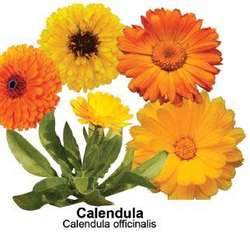calendula
calendula
Calendula
a genus of plants of the family Compositae. They are subshrubs and perennial or annual herbs with rami-form stems and entire leaves. The inflorescences are solitary calathide heads on long flower stalks. The numerous ligulate flowers are yellow, pistillate, and proliferous. The tubular flowers are bisexual but do not bear fruit. The achenes are incurved (annular); the exterior achenes are shaped differently from the middle and interior ones. There are more than 20 species of Calendula, distributed primarily from the Mediterranean region to Iran. Species are also found in Central Europe; there are four species in the USSR. They grow along seacoasts, in shrub thickets, and on cliffs. Some species, such as the marigold (Calendula arvensis), grow as weeds. Many varieties of the pot marigold (C. officinalis) have been cultivated for a long time. This species has mainly double yellow and orange flowers of all shades. It is also a medicinal plant, providing a gargle for inflamed mouth infections and an ointment for boils, wounds, and ulcers. The oily extract from the ligulate flowers is used as a food dye. In some countries, dried calathide heads are used as a seasoning for soups and sauces.
O. M. POLETIKO
